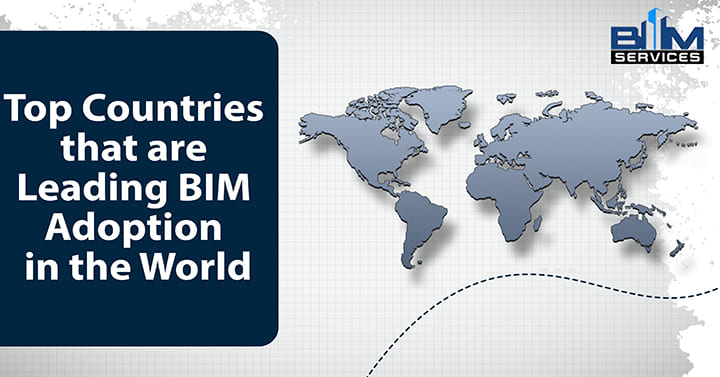Top Countries that are Leading BIM Adoption in the World

Introduction
The construction industry is experiencing a remarkable shift, thanks to the rise of Building Information Modeling (BIM). This groundbreaking approach to project planning and execution has captured the attention of professionals worldwide, leading to its widespread adoption in many countries. The reasons behind this surge in popularity are the numerous benefits that BIM Modeling Services bring to the table. One of the key drivers behind the adoption of BIM is its ability to mitigate risks and improve project outcomes which is why most construction businesses utilize the services of a BIM Company. Recognizing the immense potential of BIM, countries worldwide are swiftly adopting policies and mandating its use in public infrastructure projects. By embracing BIM, these nations aim to enhance project quality, reduce costs, and foster innovation in the construction industry. In this article, we will explore how countries around the globe are embracing this transformative technology to reshape the construction landscape.
Top Leaders in BIM adoption
BIM adoption in the UK:
The United Kingdom has solidified its position as a global leader in the adoption of Building Information modeling (BIM) within the construction industry. With a high number of construction companies utilizing BIM at Level 2 and beyond, the UK stands at the forefront of implementing this transformative technology. Since 2016, all state-funded projects in the UK are required to use at least BIM Level 2, resulting in a surge of awareness and utilization of BIM in the past decade. While BIM usage is advised but not mandatory for private projects, the impact of BIM on the industry has been significant. The UK’s BIM adoption has been exemplified in projects like the reconstruction of Heathrow Airport, where BIM was utilized for enhanced collaboration, clash detection, and efficient project management, leading to cost savings and improved construction quality.
Table of Contents
BIM adoption in Europe:
Various European countries have been adopting BIM with western Europe leading the way.
- Germany: Approximately 70% of German construction companies have embraced BIM at different levels, with a significant focus on architects and design firms utilizing BIM primarily in the design phase. Since 2017, BIM has become mandatory for projects exceeding €100 million, and as of December 31, 2020, it has also become mandatory for all public contracts related to federal infrastructure construction.
- France: France, currently lacking a single enshrined BIM standard in law or regulation, has witnessed notable adoption rates among real estate developers, with 35% incorporating BIM into their projects. Additionally, 50 to 60% of construction market leaders have transitioned to BIM, with Level 2 being the most common maturity level. The introduction of initiatives like BIM Plan 2022 aimed to encourage the integration of BIM into workflows.
- The Netherlands: The Netherlands stands as a leader in BIM adoption among architects in Europe, with an impressive 80% of architects having utilized BIM in their projects. The country’s approach to BIM implementation is facilitated by the uniformity of design in residential projects, which reduces the cost of BIM implementation when design changes are unnecessary. The development of national BIM standards, such as VISI, demonstrates the Netherlands’ commitment to standardized BIM practices.
BIM adoption in the USA:
BIM adoption in the USA has seen substantial growth, with the majority of large architecture firms and a significant number of small firms embracing it. BIM utilization is prevalent in the design industry, and its adoption has notably increased in North America over the years. While there is no nationwide regulation mandating BIM for government construction projects, it has been widely adopted by government agencies such as the Department of Defense and the General Services Administration. Notable US projects, including the Oakland International Airport and Silver Oak Winery, have successfully implemented BIM, offering benefits such as improved communication, efficient project management, and time and cost savings.
BIM adoption in Russia:
Russia has rapidly embraced BIM and has made remarkable progress in its adoption within the construction industry. Although its first BIM projects only emerged in 2014, Russia is on an upward trajectory and has become a clear leader in BIM compliance and harnessing advanced BIM technology to drive efficiencies. The country has demonstrated its commitment to BIM implementation through the establishment of 15 national standards (GOSTs) and eight sets of rules for information modeling. Since March 2022, the Russian government has made it mandatory for all government projects to use BIM technology. Large property developers and construction companies operating in major cities like Moscow, St. Petersburg, and Kazan have widely adopted BIM technology.
BIM adoption in Asia:
Asian powerhouses like China and Singapore are leading the adoption of BIM in Asia.
- Singapore: Singapore is one of the few countries in Asia that has implemented BIM, with the Building and Construction Authority (BCA) implementing the BIM Roadmap in 2010. Since then, BIM has been mandated on all public projects since 2015, and the government has allocated a total of S$250 million for successful BIM implementation. The BCA has also developed the “Singapore BIM Guide” and “BIM Particular Conditions” to help the industry adopt BIM. In Singapore, BIM has been used in projects such as the Marina Bay Sands Integrated Resort, the National University Hospital, and the Singapore Sports Hub.
- China: BIM adoption in China has increased significantly since 2016, with designers and companies integrating a high level of BIM adoption in a context of rapid building growth and industry modernization. In China, BIM has been used in various projects, including the Beijing Daxing International Airport, the Guangzhou-Shenzhen-Hong Kong Express Rail Link, and the Shanghai Tower.
Conclusion
It’s fascinating to witness how BIM is being embraced worldwide, transforming the construction industry. Different countries have taken unique approaches, but the common goal is clear: to make construction more efficient and cost-effective. This global shift towards BIM adoption reflects the recognition of its immense value and its potential to enhance construction practices on a global scale.